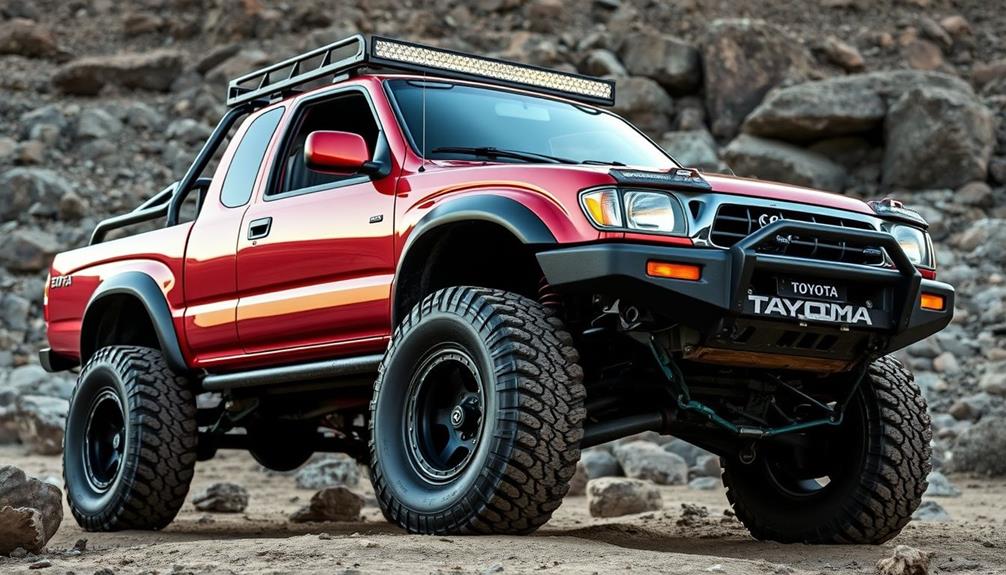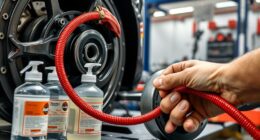If you want to boost the power and off-road capability of your 1999 Toyota Tacoma, consider several tuning options. Installing a supercharger can give you a solid horsepower increase, while a turbocharger can elevate performance dramatically. Upgrading your exhaust system and adding a cold air intake are effective ways to enhance engine efficiency. Don't forget about reliable maintenance; regular oil changes and checks are essential after modifications. Investing wisely in these upgrades not only enhances performance but can also improve resale value. There's plenty more to discover about maximizing your Tacoma's potential!
Key Takeaways
- Installing a supercharger can yield significant horsepower gains, reaching up to 100 HP with proper tuning and supporting modifications.
- Turbocharging the Tacoma can enhance performance, achieving over 350 WHP at optimal boost levels with a starting investment of around $3,000.
- Upgrading exhaust systems and headers can provide additional horsepower and improve engine efficiency, typically adding 5 to 15 HP.
- Regular maintenance, including oil changes and air-fuel ratio tuning, is crucial for reliability after performance enhancements.
- Enhancements like lift kits and aftermarket headers improve off-road capabilities and torque, making the Tacoma more versatile for challenging terrains.
Methods to Increase Horsepower
When it comes to boosting horsepower in your 1999 Toyota Tacoma, there are several effective methods you can consider. One of the most impactful upgrades is installing a supercharger. This can give you a considerable horsepower increase of about 40 HP, and with proper tuning and supporting modifications like a 7th injector, you could see gains of 70-100 HP.
Cold air intakes (CAIs) are another popular option, but be cautious; they generally offer minimal horsepower improvements, especially if they draw air from within the engine compartment. True cold air systems can make a difference, so choose wisely.
Upgrading your exhaust systems, particularly with headers, can provide an additional 5 to 15 HP when tuned correctly. This not only enhances power but also improves engine efficiency and power delivery.
If you're looking for a more aggressive boost, consider turbocharging your Tacoma's engine. With the right tuning, you can achieve over 350 WHP at 20 psi, showcasing a powerful method to enhance performance considerably.
Cost and Investment Considerations
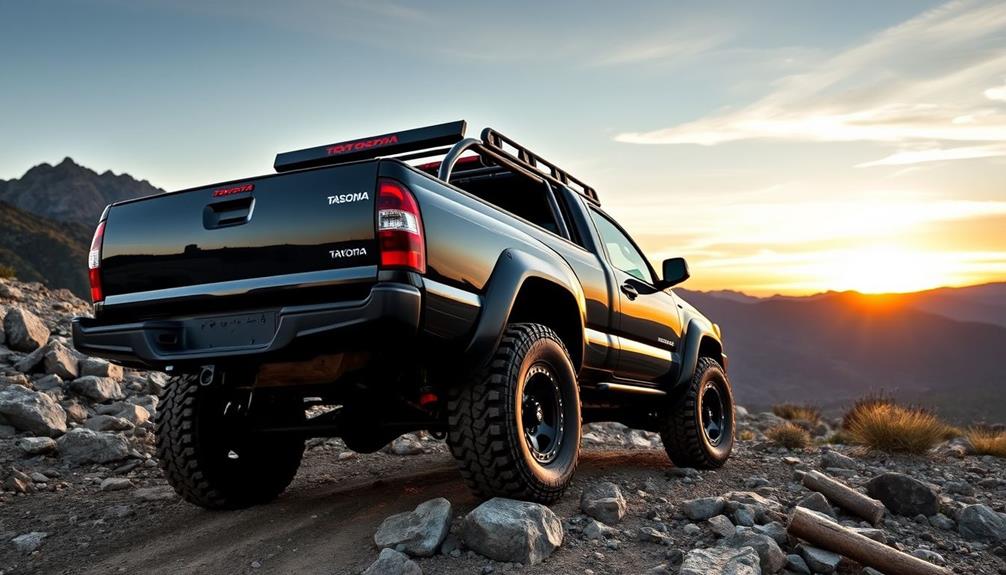
When considering upgrades for your 1999 Toyota Tacoma, it's essential to evaluate both the costs and long-term benefits.
While you might be tempted to go for basic modifications, investing in forced induction like a supercharger can provide substantial horsepower gains that make it a smarter choice.
Weighing the upfront costs against the performance improvements will help you make a more informed decision.
Performance Upgrade Costs
Performance upgrades for your 1999 Toyota Tacoma can require a substantial financial commitment, but understanding the costs involved is vital.
If you're looking for a solid performance boost, a quality turbo kit starts around $3,000, not including necessary components like a piggyback tuning unit. While basic modifications, such as cold air intakes and exhaust systems, can exceed $1,000, they often provide limited horsepower gains compared to more significant upgrades.
On the other hand, investing in a supercharger can yield impressive returns, potentially increasing horsepower by up to 80 HP when paired with proper tuning. However, you'll need to account for supporting mods like larger injectors and upgraded fuel pumps, which can bring your total investment to about $4,000.
When considering your options, it's important to weigh the upfront costs against their long-term benefits. Spending on minor upgrades mightn't give you the substantial returns you're hoping for, especially when compared to impactful enhancements like forced induction.
As a result, make informed choices to maximize your Tacoma's performance without overspending.
Long-Term Investment Benefits
Investing in long-term performance upgrades for your 1999 Toyota Tacoma can greatly enhance both its driving experience and resale value. If you're evaluating modifications, focusing on robust options like a supercharger can yield impressive horsepower gains—between 40 to 100 HP—making it a smart long-term investment.
Additionally, understanding the financial implications of these upgrades is fundamental, as they can affect your overall budget and investment strategy.
Here are some key benefits to evaluate:
- Significant Power Boost: A supercharger offers far greater performance than basic mods, providing a real return on investment.
- Cost-Effective Alternatives: While typical upgrades might cost over $1,000 with minimal gains, a turbo kit or supercharger can enhance performance without breaking the bank.
- Increased Resale Value: Tacoma owners who invest in forced induction systems often see a better resale value due to enhanced capabilities.
- Enhanced Off-Road Experience: Better power means improved performance in challenging conditions, making your Tacoma more versatile.
Performance Expectations

Tuning your 1999 Toyota Tacoma can release a world of potential, transforming it into a more powerful and responsive machine. With the right modifications, you can expect significant performance boosts that enhance both on-road and off-road capabilities. Performance tuners like the AEM FIC6 can refine your air-fuel ratios to around 12:1, enhancing fuel maps and ignition timing for improved efficiency. If you’re looking to further enhance your 1999 Toyota Tacoma’s performance, consider upgrading to high-flow air filters and aftermarket exhaust systems. These modifications can improve airflow and reduce back pressure, resulting in more power and a more aggressive engine sound. Additionally, you may also want to explore 2002 Chevrolet S10 power tuning options, as they can provide valuable insights and ideas for optimizing your Tacoma’s engine performance.
Here's a brief overview of what you can expect from various tuning options:
| Modification Type | Expected Power Gain | Notes |
|---|---|---|
| Cold Air Intake | 10-15 RWHP | Basic mod for better airflow |
| Exhaust System | 10-15 RWHP | Reduces back pressure |
| Turbocharger Setup | 100+ HP | Requires ideal management |
Utilizing turbocharger setups, you can achieve real-world power gains of 30-50 RWHP with basic modifications. Keeping boost levels at around 7 psi is ideal for the Tacoma's 2RZ engine, ensuring you maintain reliable performance. If you're venturing into high-altitude areas, remember to adjust your tuning to compensate for decreased air density, maximizing your Tacoma's potential wherever you go.
Reliability and Maintenance
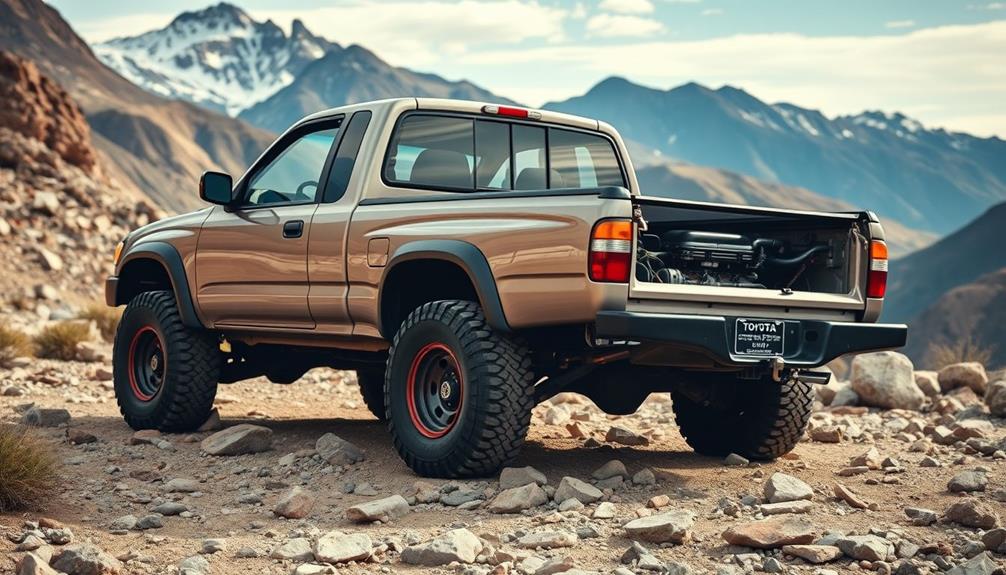
After enhancing your 1999 Toyota Tacoma's performance, maintaining its reliability becomes just as important. Regular maintenance is essential, especially when you've made modifications that can increase wear and tear.
Here are four important maintenance tasks to keep your Tacoma running smoothly:
- Oil Changes: Regular oil changes are crucial for engine health. Use high-quality oil to support your performance upgrades.
- Fluid Checks: Always check and top off fluids, including coolant and transmission fluid, to prevent overheating or other issues.
- Head Gasket Inspection: Consider upgrading to MLS head gaskets and ARP head studs to enhance durability under increased performance demands.
- Air-Fuel Ratio Tuning: Properly tuning the air-fuel ratio prevents engine knock and maintains smooth operation, particularly with forced induction setups.
Taking these steps will help you maintain the reliability of your Tacoma while enjoying its boosted power.
Community Insights

When you connect with the Toyota Tacoma community, you'll find a wealth of shared tuning experiences and performance upgrade recommendations.
Enthusiasts often discuss their forum contributions, which can guide you in making effective modifications.
Don't hesitate to ask questions and share your own journey; it's all about learning from one another.
Enthusiast Forum Contributions
The Toyota Tacoma enthusiast community is buzzing with insights on how to unseal the full potential of the 1999 model through various modifications. If you're looking to boost performance, here are some key takeaways:
- Supercharger Installations: Many forum members swear by supercharger installations, often reporting gains of over 80 HP when properly tuned.
- Tuning with AEM FIC6: The AEM FIC6 piggyback unit is highly recommended for better fuel mapping and boost management, essential for maximizing your Tacoma's power.
- Engine Durability Upgrades: Don't overlook the importance of upgrading to ARP head studs and MLS head gaskets to guarantee your engine can handle the increased power.
- Air-Fuel Ratio Maintenance: Maintaining an air-fuel ratio around 12:1 is critical for peak engine performance, especially when you're pushing higher boost levels.
Also, be cautious with K&N intakes, as they can lead to MAF sensor fouling. Proper oiling and maintenance are fundamental to avoid performance issues.
Engaging with the community can provide further insights and recommendations tailored to your specific goals for your Toyota Tacoma.
Shared Tuning Experiences
Within the Tacoma community, enthusiasts are enthusiastic to share their tuning experiences, highlighting both successes and challenges. A popular topic among owners is the installation of a supercharger, with many reporting impressive horsepower gains of 70-100 HP when properly tuned.
This upgrade often takes center stage in discussions, overshadowing other modifications like cold air intakes. While cold air intakes can enhance engine sound, most users agree their actual power increase is minimal, making them less appealing compared to forced induction.
Tuning for high-altitude performance is also frequently mentioned, as adjusting the air-fuel mixture is vital to maintain power in thinner air conditions. Many have praised the deckplate mod for improving airflow, but it's important to manage it carefully to avoid engine damage in wet or dusty environments.
Aftermarket headers and exhaust systems come highly recommended too. Owners appreciate the noticeable torque improvements they provide, especially for off-road climbing, even if the horsepower gains are modest.
Performance Upgrade Recommendations
Many Tacoma enthusiasts swear by supercharger installations as a game-changer for boosting performance in the 1999 model.
With the right setup, you could see power increases of up to 80 HP. If you're looking to enhance your Tacoma's capabilities, here are some recommendations:
- Supercharger Installations: Consider a supercharger for significant power gains, especially when paired with proper tuning.
- Performance Tuners: Invest in performance tuners or programmers to optimize your engine's fuel-to-air mixture and ignition timing, improving both horsepower and efficiency.
- High-Performance Exhaust System: Upgrading to a high-performance exhaust system is a cost-effective way to boost power and sound, potentially adding 5 to 15 HP.
- Lift Kits: For off-road adventures, lift kits and aftermarket shocks improve stability and ground clearance, allowing you to tackle rough terrains with ease.
Turbo Kit Basics

Installing a turbo kit on your 1999 Toyota Tacoma can dramatically boost its performance and driving experience. A typical kit starts at around $3,000, but you should factor in additional costs for supporting modifications and tuning solutions.
For peak performance, aim for a boost range between 5 to 15 psi; 7 psi is often a sweet spot for setups without extensive modifications.
Proper installation of the turbo components is essential. You'll need a wastegate to regulate boost effectively, ensuring your engine runs safely and efficiently.
With the stock 2RZ engine, you can achieve over 350 wheel horsepower at 20 psi, given you have the right tuning and supporting upgrades like larger injectors and an upgraded fuel pump.
Don't overlook the significance of calibrating the Mass Air Flow (MAF) sensor. It plays a crucial role in accurate fuel mapping, which directly impacts your engine's overall efficiency when implementing a turbo kit.
Performance Tuning Options
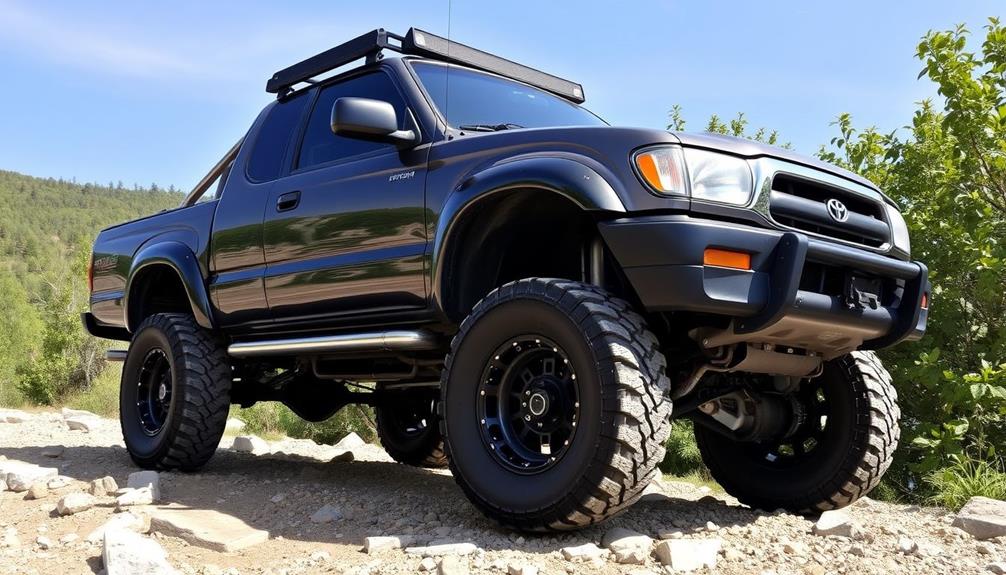
When considering performance tuning options for your 1999 Toyota Tacoma, you'll find a range of modifications that can greatly enhance power and responsiveness.
Here are some popular choices:
- Supercharger Installations: Adding a supercharger can boost your horsepower by 40 to 100 with proper tuning and supporting modifications.
- Turbo Kit: Upgrading to a turbo kit, typically costing around $3,000, can push your Tacoma to over 350 wheel horsepower at 20 psi.
- Cold Air Intakes: While often seen as low-cost upgrades, cold air intakes provide minimal horsepower gains. For significant performance enhancements, consider forced induction setups.
- Proper Tuning: Using units like the AEM FIC6 piggyback to optimize air-fuel ratios and ignition timing is essential for maximizing the performance of your modified engine.
Engine Swap Vs. Turbo Upgrade
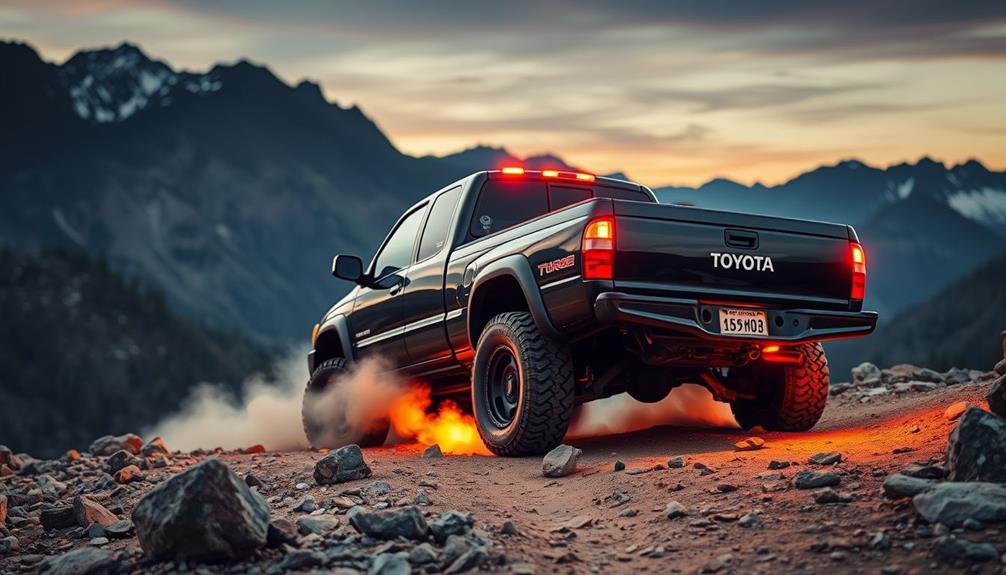
Choosing between an engine swap and a turbo upgrade for your 1999 Toyota Tacoma can greatly impact your performance goals and budget. An engine swap usually involves replacing your existing engine with a more powerful one, such as an older Supra engine. This can cost around $3,000, excluding wiring and conversion. On the other hand, a turbo upgrade enhances your current engine's performance, potentially achieving over 350 WHP at 20 psi for about $4,000, including supporting modifications.
Here's a comparison to help you decide:
| Feature | Engine Swap | Turbo Upgrade |
|---|---|---|
| Cost | ~$3,000 (excl. extras) | ~$4,000 (incl. modifications) |
| Power Potential | Higher horsepower | 350+ WHP at 20 psi |
| Modifications | Extensive required | Minimal, leverages stock engine |
| Incremental Upgrade | Less flexibility | Easier to manage costs over time |
| Reliability | More complexity and risk | Generally more reliable |
Ultimately, while both options boost performance, the turbo upgrade may offer a more straightforward and manageable path for your Tacoma TRD.
Benefits of Performance Programmers
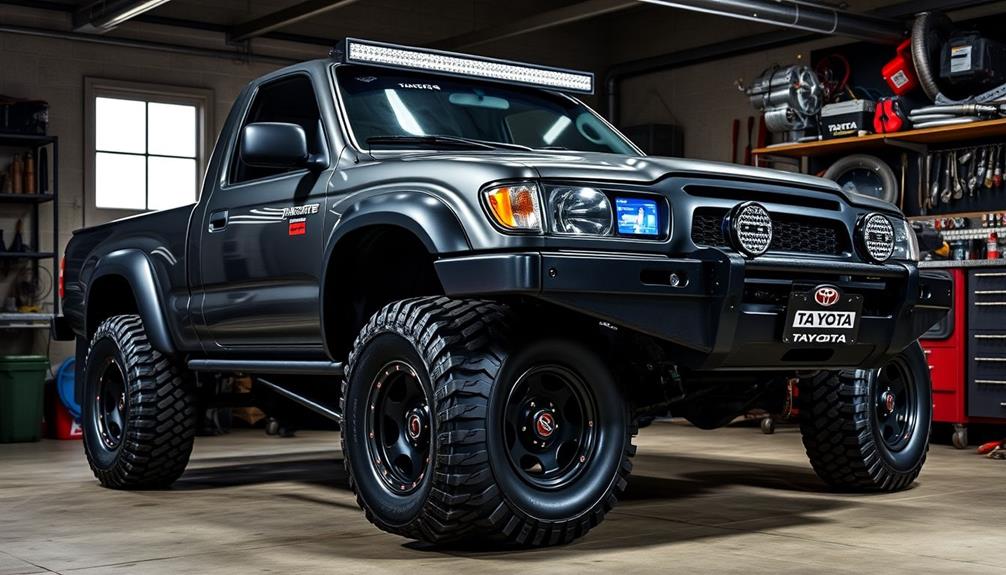
Releasing the full potential of your 1999 Toyota Tacoma can be as simple as using a performance programmer. These devices enhance your truck's engine performance, and you'll enjoy several benefits, including:
- Increased Horsepower: Performance programmers can boost your Tacoma's horsepower and torque by up to 20%, giving you that extra edge on and off the road.
- Customizable Tuning: You can adjust key parameters like ignition timing and air/fuel mixture, optimizing your engine for various driving conditions and preferences.
- Easy Installation: Most performance programmers are designed for plug-and-play use via the OBDII port, making it accessible for DIY enthusiasts without any extensive mechanical knowledge.
- Real-Time Monitoring: Advanced features allow for data logging and real-time insights into engine performance, helping you gauge the effectiveness of your tuning.
Utilizing a performance programmer not only increases horsepower but also improves fuel efficiency.
Frequently Asked Questions
How to Increase Power in Toyota Tacoma?
To increase power in your vehicle, consider installing a supercharger or turbo kit, upgrading the exhaust system, and optimizing the engine tune. These modifications can greatly enhance performance, giving you the power you desire.
How Much HP Can You Get Out of a Tacoma?
You could release a roaring beast with your Tacoma! Depending on modifications, you can easily crank out an extra 40 to over 350 horsepower, transforming your ride into an unstoppable force on and off the road.
How Much Can a Toyota Tacoma Off-Road Pull?
When you're off-road, a Toyota Tacoma can typically pull between 3,500 to 5,000 pounds, depending on its configuration. Upgrades like better brakes and suspension enhance its stability and towing capabilities on rugged terrains.
What Is the Extra Power Button on a Toyota Tacoma?
Powerful performance's pivotal! The extra power button on your Tacoma boosts throttle response, enhances torque, and optimizes shifts. It's perfect for tough terrains, but remember, it can sip fuel faster when engaged. Use wisely!
Conclusion
To sum up, tuning your 1999 Toyota Tacoma can truly transform your driving experience, especially when it comes to boosting both power and off-road capability. While some might argue that an engine swap is the ultimate upgrade, many find that a turbo kit offers a perfect blend of performance and cost-effectiveness. Ultimately, the real secret lies in understanding your specific needs and goals—after all, a well-tuned Tacoma can turn every adventure into an unforgettable journey!
